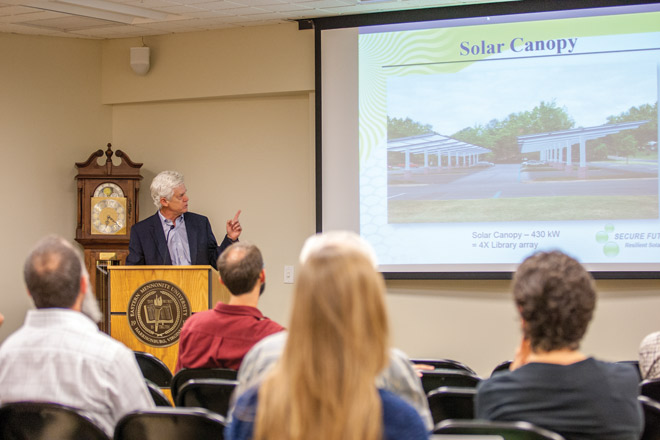
Eastern Mennonite University and Secure Futures, LLC – led by Anthony Smith, PhD (pictured) – have announced plans for a second solar array on campus, operational by the summer of 2015. (Photo by Michael Sheeler)
Four years after a 104-kilowatt solar panel array on the roof of EMU’s Hartzler Library came online, the university has announced plans to significantly expand its commitment to renewable energy with more solar panels on and beside the University Commons.
The new installation, expected to be in operation by the summer of 2015, will be able to generate 511 kilowatts of electricity (as measured in “direct-current” or DC power). The panels will be mounted on canopies above the University Commons parking lot and on that building’s roof. Along with the original library array, the new installation should allow EMU to produce up to 14 percent of its annual electric demand from solar energy.
“That’s a huge percentage,” said Drew Gallagher, Virginia campus organizer with the Chesapeake Climate Action Network who attended a public meeting in early October announcing the new solar initiative. Afterwards, in an email to EMU President Loren Swartzendruber, Gallagher wrote of his plans to begin “showcasing EMU’s efforts as your campus is on the cutting edge among Virginia colleges.”
As was the case with the installation on the library roof, EMU has entered an agreement with Secure Futures, a solar energy development company based in Staunton, Virginia, to install, operate and maintain the new array. Secure Futures president and CEO Anthony Smith is also a professor at EMU’s master’s of business administration program.
The new solar project will proceed under a unique “customer self-generation agreement” between EMU and Secure Futures. The arrangement, devised by Secure Futures to overcome various regulatory hurdles that have made Virginia a relatively difficult state for solar energy development, requires no capital investment from EMU and will reduce the university’s electric bill from the very start.
EMU will achieve additional across-the-board operational savings with the help of a natural gas generator that will be installed at the same time as the solar panels. The generator will help the university lower its peak electric demand, a measurement of consumption used to set electric rates throughout the year. With the additional solar capacity and occasional help from the generator – primarily during the winter, when the solar panels produce less electricity – that lower peak demand will put EMU on a cheaper rate scale with the Harrisonburg Electric Commission, Smith said. — Andrew Jenner